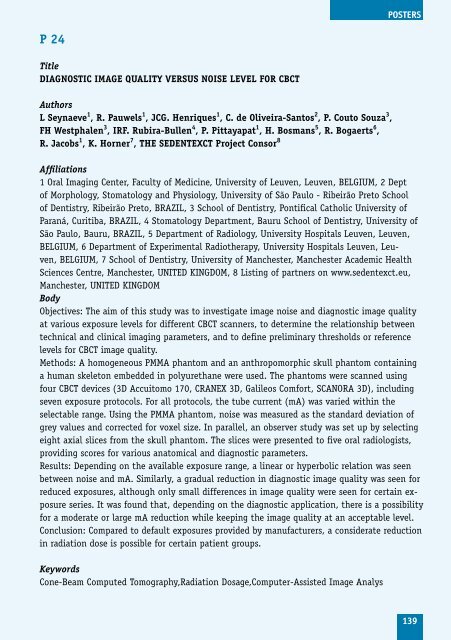Program including abstracts as pdf available here
Program including abstracts as pdf available here
Program including abstracts as pdf available here
Create successful ePaper yourself
Turn your PDF publications into a flip-book with our unique Google optimized e-Paper software.
P 24<br />
Title<br />
DIAGNOSTIC IMAGE QuALITy VERSuS NOISE LEVEL FOR CbCT<br />
Authors<br />
L Seynaeve 1 , R. Pauwels 1 , JCG. Henriques 1 , C. de Oliveira-Santos 2 , P. Couto Souza 3 ,<br />
FH Westphalen 3 , IRF. Rubira-bullen 4 , P. Pittayapat 1 , H. bosmans 5 , R. bogaerts 6 ,<br />
R. Jacobs 1 , K. Horner 7 , THE SEDENTEXCT Project Consor 8<br />
Affiliations<br />
1 Oral Imaging Center, Faculty of Medicine, University of Leuven, Leuven, BELGIUM, 2 Dept<br />
of Morphology, Stomatology and Physiology, University of São Paulo - Ribeirão Preto School<br />
of Dentistry, Ribeirão Preto, BRAZIL, 3 School of Dentistry, Pontifical Catholic University of<br />
Paraná, Curitiba, BRAZIL, 4 Stomatology Department, Bauru School of Dentistry, University of<br />
São Paulo, Bauru, BRAZIL, 5 Department of Radiology, University Hospitals Leuven, Leuven,<br />
BELGIUM, 6 Department of Experimental Radiotherapy, University Hospitals Leuven, Leuven,<br />
BELGIUM, 7 School of Dentistry, University of Manchester, Manchester Academic Health<br />
Sciences Centre, Manchester, UNITED KINGDOM, 8 Listing of partners on www.sedentexct.eu,<br />
Manchester, UNITED KINGDOM<br />
Body<br />
Objectives: The aim of this study w<strong>as</strong> to investigate image noise and diagnostic image quality<br />
at various exposure levels for different CBCT scanners, to determine the relationship between<br />
technical and clinical imaging parameters, and to define preliminary thresholds or reference<br />
levels for CBCT image quality.<br />
Methods: A homogeneous PMMA phantom and an anthropomorphic skull phantom containing<br />
a human skeleton embedded in polyurethane were used. The phantoms were scanned using<br />
four CBCT devices (3D Accuitomo 170, CRANEX 3D, Galileos Comfort, SCANORA 3D), <strong>including</strong><br />
seven exposure protocols. For all protocols, the tube current (mA) w<strong>as</strong> varied within the<br />
selectable range. Using the PMMA phantom, noise w<strong>as</strong> me<strong>as</strong>ured <strong>as</strong> the standard deviation of<br />
grey values and corrected for voxel size. In parallel, an observer study w<strong>as</strong> set up by selecting<br />
eight axial slices from the skull phantom. The slices were presented to five oral radiologists,<br />
providing scores for various anatomical and diagnostic parameters.<br />
Results: Depending on the <strong>available</strong> exposure range, a linear or hyperbolic relation w<strong>as</strong> seen<br />
between noise and mA. Similarly, a gradual reduction in diagnostic image quality w<strong>as</strong> seen for<br />
reduced exposures, although only small differences in image quality were seen for certain exposure<br />
series. It w<strong>as</strong> found that, depending on the diagnostic application, t<strong>here</strong> is a possibility<br />
for a moderate or large mA reduction while keeping the image quality at an acceptable level.<br />
Conclusion: Compared to default exposures provided by manufacturers, a considerate reduction<br />
in radiation dose is possible for certain patient groups.<br />
Keywords<br />
Cone-Beam Computed Tomography,Radiation Dosage,Computer-Assisted Image Analys<br />
POSTerS<br />
139


